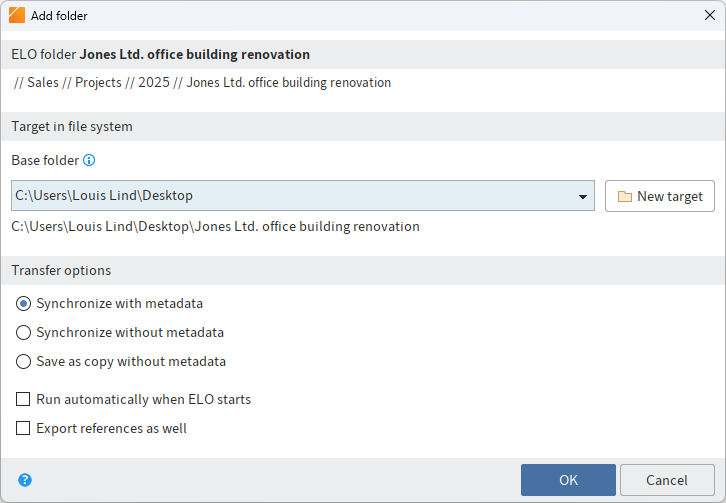# Synchronize entries
# Folder synchronization
Available in: Ribbon > Output > External link
The Folder synchronization function enables you to synchronize data in an ELO folder with an external file system or a mobile device or create a copy of the folder. For example, you can take all the documents you need to external appointments and then import any changes back into ELO.
Requirement: First you need to map the ELO folder to an external folder via Output > External link > Configure folder.
ELO checks whether synchronization folders from known cloud service providers are located on your computer. You are then asked if you want to use these folders as counterparts for folders in ELO. You can also synchronize folder pairs of your choice. The function automatically synchronizes data in both directions. In addition to synchronizing documents, it is also possible to map folder structures.
You can access data in your provider's cloud and edit it from any Internet-ready device. Once you log back on to the ELO Java Client, you can transfer changes or new files to ELO.
Important
As you can synchronize in both directions, this may cause documents to be deleted on the computer's file system.
The following describes how to use folder synchronization once you have set up least one folder pair. You can find more information on how to do this in the section Configure folder.
Method
On the ribbon, select Output > External link > Folder synchronization.

The Folder synchronization dialog box opens. You will see existing folder pairs and the status of the last synchronization run.
The dialog box contains the following options:
Start (green triangle): Starts synchronization for the respective folder pair
Please note
If you have enabled the option Synchronize without metadata in the settings and add a file to the folder in the file system, the file name must start with a plus icon (+) so that it is transferred to ELO during synchronization. The plus icon in the file name is automatically removed during synchronization.
Settings (gear icon): Opens the Add folder dialog box You can change the settings for the respective folder pair here. If the settings for a folder pair were changed, you will see an orange bar in front of the folder pair in the Folder synchronization dialog box.
Delete (X icon): Removes the folder pair
Information
Deleting a folder pair does not delete the folders themselves. It only removes the folder mapping.
Start all: Starts synchronization for all available folder pairs
Please note
If you delete and edit the JSON files, you will lose important data about the synchronization process.
# Configure folder
Available in: Ribbon > Output > External link
The Configure folder function enables you to configure an ELO folder for synchronization with a folder outside of ELO or save a copy.
To select a folder for synchronization, follow the steps below.
Select a folder in ELO.
On the ribbon, select Output > External link > Configure folder.

In the Add folder dialog box, you specify the target folder in the file system and define the transmission settings.
# ELO folder
Under ELO folder, you can see the folder selected in ELO.
# Target in file system
Under Target in file system, you can see the folder selected as the target in the file system. You can select existing paths from the drop-down menu of the Base folder field. Select New target to assign a different folder.
Information
The module automatically searches for cloud folders from the following providers: Dropbox, Google Drive, Microsoft OneDrive, GMX MediaCenter, WEB.DE Online-Speicher, and SpiderOak Hive. If this kind of folder is detected on the computer's file system, ELO automatically enters the detected path under Base folder.
# Transfer options
In the Transfer options area, you can adjust the synchronization settings. The following settings are available:
Synchronize, with metadata: The folders selected above are synchronized. An additional file is stored on the file system for each synchronized entry (folder or document). This additional file saves the metadata of the synchronized entry in JSON format.
Synchronize without metadata: The folders selected above are synchronized. This option synchronizes the documents and child folders but ignores the metadata. If you add a file to the folder in the file system, the file name must start with a plus icon (+) so that it is transferred to ELO during synchronization. The plus icon in the file name is automatically removed during synchronization.
Save as copy without metadata: The Save as copy option saves an identical copy of the folder to the Windows file system but without metadata (GUID, metadata information).
Run automatically when ELO starts: If you select the option Run automatically when ELO starts, the base folder and ELO folder are synchronized every time ELO starts.
Please note
If you need to synchronize a large number of folders, this will delay all other processes when starting ELO. For this reason, this function is not recommended for very large directories that rarely change. In such cases, it makes more sense to create multiple folder pairs and only set up automated synchronization for selected ones.
Export references as well: Enable the Export references as well option to also export references in the folder for synchronization.
# Additional information
To start the folder synchronization, select Output > External link > Folder synchronization on the ribbon..
# Manage mobile devices
Available in: Ribbon > Output > External link
This function allows you manage the mobile devices used to transfer documents to the ELO Java Client with the ELO Connect app. The connection settings are configured in ELO Connect. A new device will only appear in the Manage mobile devices dialog box after data has been transferred.
You can rename the mobile devices or delete them from the list.
For more information, refer to the ELO Connect (opens new window) documentation.